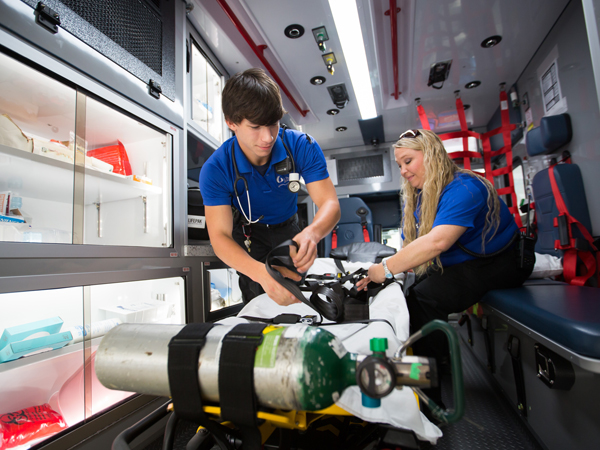State-of-the-art ambulances boost UMMC Grenada’s fleet

UMMC Grenada's advanced ambulance service just got a major technology boost.
Joining the fleet are three state-of-the-art vehicles “that will allow us to do a lot of things we couldn't do before,” said Edwin Mitchell, UMMC Grenada's manager of emergency transport.
Among the new features are an advanced suspension system that provides a better ride for patients, especially those who have experienced serious injuries. “It helps prevent further trauma in transport,” Mitchell said.
The new vehicles also are equipped with a patient- and staff-friendly power loading system.
“The stretchers are loaded from the ground to the truck and back out,” Mitchell said. “This greatly decreases the chance of injuries to patients and staff, and it increases safety for the patient by always keeping the stretcher in the transport position.”

Ambulances usually are designed for effective transport, but the new vehicles combine that and other features to provide a much better patient experience, said Dr. Damon Darsey, assistant professor of emergency medicine and medical director of the Mississippi Center for Emergency Services housed at UMMC.
The center provides medical communications and coordination during small- and large-scale events, assists in providing valuable support and emergency response, and leverages available air and ground transport to safely transport patients from affected areas.
“These advantages allow the crew not just to transport the patient, but to better care for them at the scene,” Darsey said. “We're learning more and more that care of patients pre-hospital is just as vital as the care they receive when they arrive at the emergency room.”
“The purchase of these three state-of-the-art ambulances shows UMMC's commitment to the city of Grenada, the county, patients and staff,” said Donna Norris, clinical director of the Mississippi Center for Emergency Services.
Another important safety feature is LED lighting on the vehicles' interior and exterior, Norris said.
“They provide increased visibility for the sides of ambulances for the safety of staff and other emergency responders at the scene of an accident,” she said.
UMMC Grenada owns the community's ambulance service. The service's three oldest ambulances were retired, leaving a stronger, six-vehicle fleet that's keeping abreast of the most modern health care, Mitchell said.
“We serve a very rural area, and we have a lot of sick patients,” he said. “We need this technology, especially to transport patients to the most appropriate facility.”
“Transport times can be longer in rural areas, and it can become complicated,” Darsey said. “We have limited resources, so the resources we have must be multifunctional.”
One of the fleet's most recent life-saving enhancements is technology that allows trained paramedics to insert breathing tubes into patients who have suffered a traumatic injury to their airway, head or neck. It's called a video laryngoscope, and according to Mitchell, “only a few services in our state offer this technology.” He said in rural areas, the device is typically present only in hospitals - with some hospitals not having them at all.
UMMC Grenada's ambulances respond regionally to more than 400 calls a month, ranging from general illnesses to major traumas, strokes and heart attacks. The service has been upgraded to include a 35-person staff, the addition of advanced treatment and protocols in paramedic training, and improved communications and radio interoperability with local agencies.
Mitchell urges residents who need an ambulance to call 911 rather than the ambulance service's business office. Calling 911 is standard procedure and one-stop shopping in all communities for ambulance service or other emergencies, such as incidents requiring law enforcement or assistance in case of fire.
The older ambulances in the fleet still allow excellent patient care.
“We have well beyond the state minimums on all of our units,” Mitchell said. “Plans are to standardize the entire fleet so that all units are identical.”
“Everything is geared toward patient and staff safety,” Norris said.


